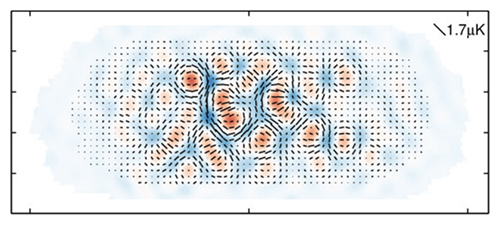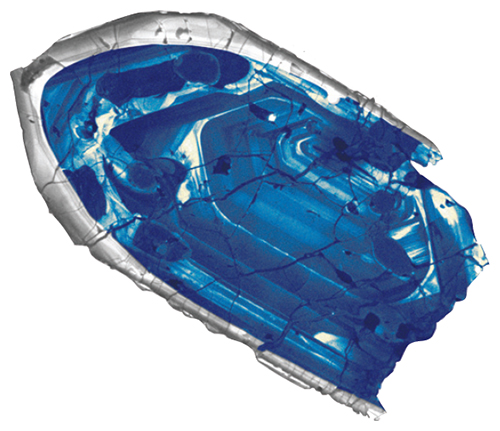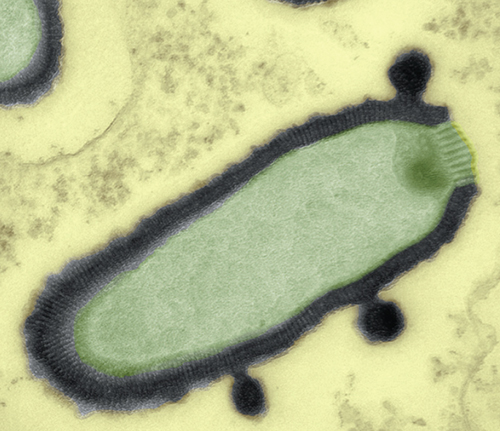
This Article From Issue
May-June 2014
Volume 102, Number 3
Page 249
DOI: 10.1511/2014.108.249
In this roundup, associate editor Katie L. Burke summarizes notable recent developments in scientific research, selected from reports compiled in the free electronic newsletter Sigma Xi SmartBrief. Online: https://www.smartbrief.com/sigmaxi/index.jsp
Big Bang Inflation Detected
Groundbreaking support for the inflation theory, which predicts that the universe underwent a period of exponential expansion immediately after the Big Bang, has been found using the BICEP2 telescope at the South Pole. The telescope detected a pattern of wave orientations, or polarization, in the ubiquitous microwave radiation left over from the Big Bang. The particular polarization pattern indicates that the newborn cosmos was awash in intense gravitational waves—ripples in space-time—just as predicted by theory. If the BICEP2 results hold up to scientific scrutiny, they will inform physicists about the timing of inflation and will offer clues about what could have triggered it in the first place. Because the inflation theory spawned the conceptual framework for a multiverse, support for the existence of other universes could be bolstered as well. Other experimenters are now seeking to confirm the findings.

BICEP2 Collaboration
BICEP2 Collaboration. BICEP2 I: Detection of B-mode polarization at degree angular scales. (in review) arxiv:1403.3985 (Submitted on March 17)
BICEP2 Collaboration. BICEP2 II: Experiment and three-year data set. (in review) arxiv:1403.4302 (Submitted on March 17)
Influence of Stem Cell Substrate
A new study has shown that stem cells have mechanical memory: Stem cell differentiation is influenced not only by the substrate on which the cells grow, but also by the past substrates on which they have lived. A team at the University of Colorado, Boulder, found that human mesenchymal cells cultured on a hard surface and then transferred to a soft surface tended to differentiate into bone cells; those grown on a soft surface, in contrast, developed into bone or fat cells. The longer the stem cells were grown on the hard surface, the better their apparent memory of it. Chun Yang and his colleagues determined that two proteins, YAP and TAZ, influence the expression of a gene called RUNX2, which induces bone cell formation. The researchers warned that culturing methods for stem cells could unintentionally influence differentiation in the lab.
Yang, C., M. W. Tibbitt, L. Basta, and K. S. Anseth. Mechanical memory and dosing influence stem cell fate. Nature Materials doi:10.1038/NMAT3889 (Published online March 16)
Oldest Bit of Earth’s Crust
A zircon crystal discovered in western Australia has been measured by two different dating methods to be 4.4 billion years old—the most ancient terrestrial sample yet found—showing that the Earth’s crust formed just 100 million years after the planet itself. Study of the zircon indicates that the surface of the very young Earth was cool enough to allow oceans, contrary to what many scientists have thought. The possibility of early oceans means that the origin of life could also have happened much earlier than commonly believed, although the first clear fossil evidence of life is from stromatolites that are 3.4 billion years old.

Photo by John Valley
Valley, J. W., et al. Hadean age for a post-magma-ocean zircon confirmed by atom-probe tomography. Nature Geoscience 7:219 (Published online February 23)
Mind-Altered Fruit Flies
Apparently, all it takes to turn on a fruit fly is a mental switch. A team of neuroscientists added channelrhodopsin, a protein sensitive to red light, to neural circuits associated with the fly’s mating behaviors. When Hidehiko K. Inagaki of Howard Hughes Medical Institute and his collaborators shined red light on the fly, the channelrhodopsin neurons fired, and the insect turned instantly amorous. In this way, the researchers could induce a fruit fly to vibrate its wings in courtship “song.” These techniques open up new ways to explore decision making in flies, and more broadly to use light to trigger neural circuits.
Inagaki, H. K., et al. Optogenetic control of Drosophila using a red-shifted channelrhodopsin reveals experience-dependent influences on courtship. Nature Methods 11:325 (Published online December 22)
Ancient Frozen Virus Revived
The largest virus yet discovered was found active in Siberian permafrost that is 30,000 years old, infecting an amoeba that was used as bait. The new virus, dubbed the pithovirus, is different from any other virus known. Matthieu Legendre of CNRS in France and his team discovered it while trying to isolate pandoraviruses, another family of giant, amoeba-infecting DNA viruses that the group had discovered earlier. The pithovirus is about 30 percent bigger than the pandoraviruses but has one-fifth as many genes; the two have only five genes in common. Its mode of replication is also different. Rather than hijacking the amoeba’s nuclear DNA, the pithovirus infects an amoeba’s vacuole and uses its own DNA to replicate—a method of replication more reminiscent of yet another family of giant viruses that Legendre and company discovered 10 years ago, the mimiviruses. The recovered pithovirus is the oldest virus shown to still be viable, and so raises a possibility that unknown pathogenic viruses could be released as permafrost thaws or is disturbed due to mining or drilling.

© Julia Bartoli & Chantal Abergel, IGS, CNRS/AMU
Legendre, M., et al. Thirty-thousand-year-old distant relative of giant icosahedral DNA viruses with a Pandoravirus morphology. Proceedings of the National Academy of Sciences of the U.S.A. 111:4274 (Published online March 3)
American Scientist Comments and Discussion
To discuss our articles or comment on them, please share them and tag American Scientist on social media platforms. Here are links to our profiles on Twitter, Facebook, and LinkedIn.
If we re-share your post, we will moderate comments/discussion following our comments policy.